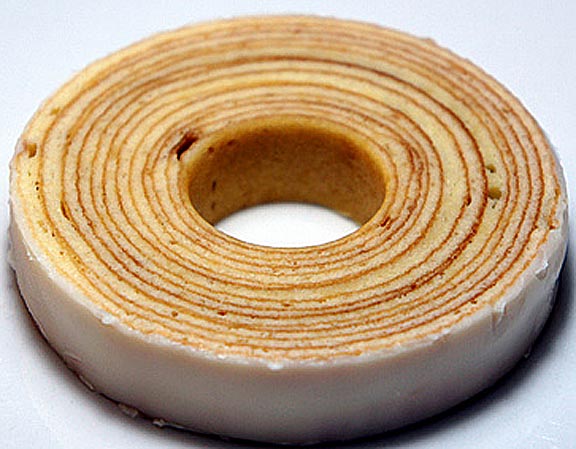

BAUMKUCHEN!!!

A slice of
glazed Baumkuchen
Introduction
Often referred to as "The King of Cakes," Baumkuchen is also one of the rarest and most expensive dessert treats, commonly costing $50.00 per pound. As of 2014, there are only five bakeries in the entire United States that make traditional German Baumkuchen. The prohibitively expensive specialty ovens and time consuming attention to detail make it impractical for most bakeries to attempt this delicacy. Because of these reasons for decades it has been considered impossible for the home baker to make true Baumkuchen... until now. This page explains how anyone can make real German Baumkuchen at home and in so doing amaze friends and families with something that's truly fantastic.
Baumkuchen, translated as tree cake, is a many-layered sponge cake baked on a rotating cylinder. As the cylinder rotates, it's coated with a thin layer of batter, allowed to bake to a light golden brown, recoated, baked again and so on until 20 or more layers are created. After cooling, it's cut off the cylinder in donut-shaped discs. When viewed from the top, the many layers look like the growth rings in a tree, hence the name. (And regarding of its name, it is incorrect to speak of Baumkuchen cake because the word Baumkuchen literally means tree cake. The "cake" noun is already present. Saying "Baumkuchen cake" is the same as saying "angel food cake cake.")
Baumkuchen comes in two traditional styles: smooth and rough. Smooth cakes are made by dipping the rotating cylinder into a vat, which coats it with a very uniform layer.
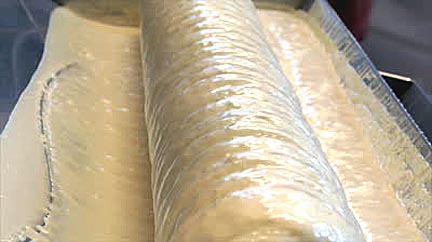
Smooth-type
Baumkuchen being dipped to apply a coat of cake batter.
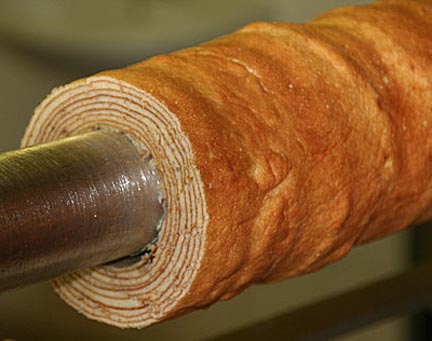
A finished
smooth-type Baumkuchen still on its baking cylinder.
The following video shows a smooth-type Baumkuchen being made:
Rough Baumkuchen has a highly textured surface because the batter is poured over the rotating cylinder, creating an uneven coating.
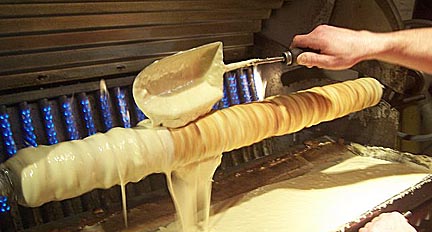
Batter being
poured over a rotating spit to form rough Baumkuchen.
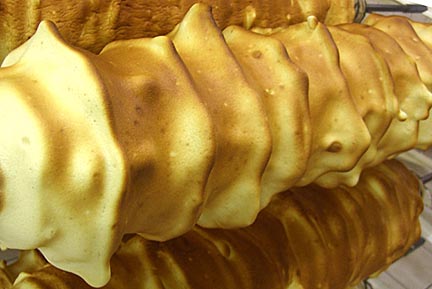
The result is
a rough surface.
This video shows the process of pouring batter to form rough Baumkuchen:
Many experts consider rough Baumkuchen the original form. Smooth Baumkuchen is more common because the surface bakes at a even rate, avoiding the problem of high spots over baking.
Baumkuchen is baked, or more accurately broiled, in special ovens with rotating cylinders one to two inches in diameter. These cylinders not only have to be motor driven in rotation but also movable so that they can be pulled out of the oven for coating then pushed back in to bake the layer of batter. Such ovens start at $20,000.00 and go as high as $100,000.00.
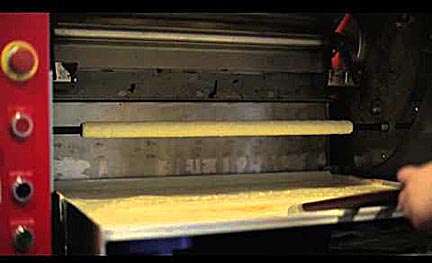
Commercial
Baumkuchen ovens can have up to 12, four-foot long spits mounted on a
rotating cylinder.
A cylinder is
dipped as it spins, the drum rotated and the next cylinder moves into
position for dipping.
As the
cylinder moves up and back into the oven they enter the heated area
where they bake.
The drum's
rotational speed is set so that by the time the first cylinder comes
out of the
oven it's
ready for another coat of batter.
Whereas conventional ovens can be used for baking many different types of cakes well as a host of other items, Baumkuchen ovens are so specialized they can only be used for one thing. Equally restrictive for the baker who's considering entering into the Baumkuchen arena is that unlike regular cakes, that can be put into an oven and forgotten until done, baking Baumkuchen requires constant attention with specific actions being completed every few minutes. Tying up a baker full time on one task is too expensive for most bakeries to undertake.
Although it originated in Germany, Baumkuchen has been enthusiastically adopted by Japan to the point where that country is now considered to produce the best Baumkuchen in the world.
The question is: "Why bother?
Every baker knows that the best tasting part of any cake is the thin caramelized layer that sticks to the bottom of the pan. Hundreds of years ago, a German baker got the inspired idea of creating a cake whose body was filled with layer upon layer of this richly flavored delicacy. Eventually he or she figured out the only way to do it was on the rotating spit usually used for broiling roasts. The idea caught on and soon bakeries specializing in Baumkuchen sprang up all over Germany. Unfortunately, its very popularity led to people inventing inferior products and labeling them as Baumkuchen. Baked flat-layer-on-layer in conventional cake pans, these torte-like cakes are all that the home baker could produce.
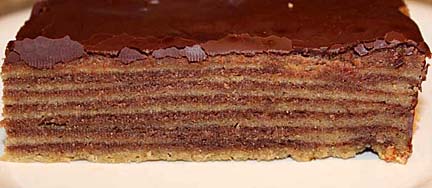
Flat, pan-made
Baumkuchen want-to-be.
They can be tasty, but lack the elegance and texture of true Baumkuchen. Fortunately, that's all about to change.
The key to making Baumkuchen at home is the oven. It has to have both a broil function and a rotisserie. I found Walmart sells a Hamilton Beach oven with these features for only $69.00 (2014.) I removed the racks and replaced the drip pan with a sheet of aluminum foil.
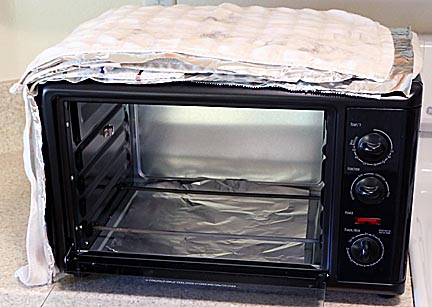
To keep the heat as high as possible, I placed a cake rack on the top of the oven then alternated layers of aluminum foil, to block radiation losses, and old dish towels, to reduce convention and conduction losses. Doing this cuts the baking time down from ten minutes per layer to 7 minutes. This is important because the longer it takes to bake a layer the more dried out it's going to get. WARNING! Insulating the oven like this increases the risk of fire. Do so at your own risk. Also, be sure to avoid covering the oven's cooling vents.
Next we need the cylinder on which the layers of cake are baked. I made mine from an 11-inch long piece of 2-inch diameter cardboard mailing tube.
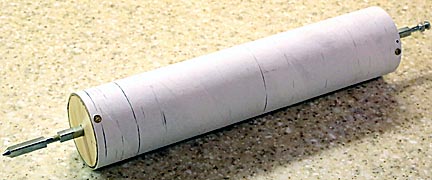
After cutting two wood disks that fit snuggly into the tube, I drilled 1/4-inch holes in the center of each, then used a small file to reform them into square holes just large enough to hold the 1/4-inch square rotisserie rod. The wood disks were screwed to the tube while the rotisserie rod was in them to make sure the holes were aligned properly.
Prior to baking, the cylinder is wrapped in non-stick aluminum foil with a length of string tied around the middle to keep the foil in place. Crimping the ends of the foil around the rotisserie rod keeps the cylinder centered.
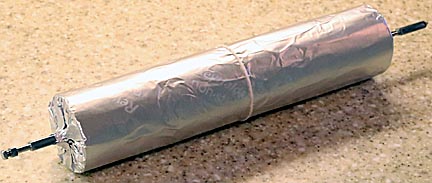
Using
non-stick foil not only protects the cardboard cylinder,
it also makes
it easy to slide off slices after cutting.
While any pan could serve to hold the batter, it's convenient if the one selected is long enough so you don't have to stick your hands inside the hot oven. I found Walmart sold a pair of rectangular range burner covers for $14.00 in 2014. These were 12-inches wide, 18-inches long and 2-inches high.
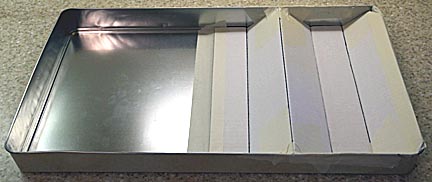
Filing the entire pan with batter would be wasteful so I used cardboard to create a narrow trough for the batter at one end. This section is covered with aluminum foil prior to filling.
Turn the oven on to broil and rotisserie to warm up while you make the batter. Do not insert the cylinder at this time.
The following is the best recipe I could find for traditional rotisserie-baked Baumkuchen:
10 eggs, separated
3/4-cup soft butter
3/4-cup sugar
1 teaspoon real vanilla
1 cup all purpose flour
1/2 cup corn starch
1/4 teaspoon salt
1/4-cup sugar (for the meringue)
Beat the salt, vanilla, butter and 3/4-cup sugar until light and fluffy. Beat the egg yolks until light and lemon-colored. Beat these two mixtures together. Combine the flour and corn starch and mix into the wet ingredients. Being careful to thoroughly wash the beaters, beat the egg white into a soft meringue, then slowly add the 1/4-cup sugar while continuing to beat to form soft peaks. Fold the meringue a quarter at a time into the cake batter. Pour some of this mixture into the trough. Insert the cylinder into the oven, holding the end of the pan position it under the rotating cylinder and lift it just enough so the cylinder gets a single, even coat of batter. Remove the pan, close the door and let this first layer bake for 4 minutes. Open the door and add a second layer, close, bake for 2 minutes and repeat a third time. This time let the oven bake for 7 minutes or until the outer layer starts to have a light golden color. Then add three more coats waiting 2 minutes between the first and second and letting the third one bake for 7 minutes. Repeat until the cake is as large in diameter as you want.
The very first layer has a hard time sticking to the non-stick foil. Letting it bake for 4 minutes lets it dry out enough so that when you add the second coat the first one won't pull off. After that, only 2 minutes between coats is needed to set the batter enough so that it isn't pulled off by the following coat.
Real Baumkuchen ovens operate at extremely high temperature, baking a layer in just two minutes. Also, the cylinders rotate at 60 revolutions per minute, which is fast enough to hold onto a thick layer of batter. The oven I'm using is much cooler, as evidenced by the fact it takes 7 minutes instead of 2 to brown a layer, and rotates at only 2 revolutions per minute. This slower rotation means if too thick a layer of batter is applied it'll slide off before it bakes. Applying four layers before letting one bake until light brown makes up for these deficiencies.
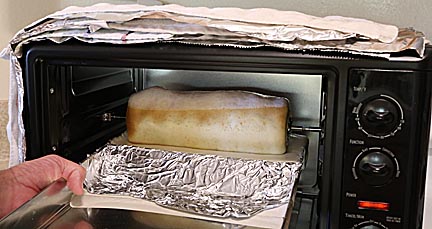
Adding a layer
of batter to a Baumkuchen starting to take shape.
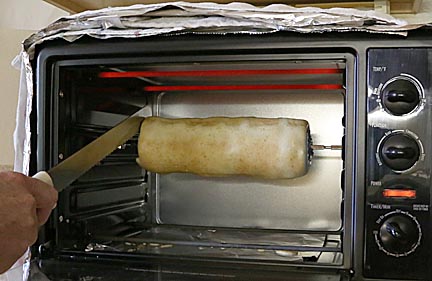
Batter tends
to build up on the ends and can eventually make the cake so long it
won't fit in the trough.
When this
happens, use a sharp, serrated knife to trim the ends off.
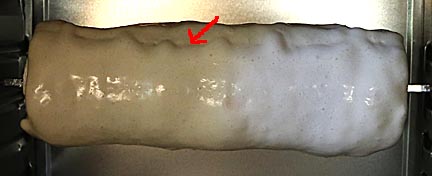
Every time the
batter pan is lowered after applying a coat of batter, a drip line
forms (red arrow.)
Make sure the
following drip lines don't overlap previous ones or you could end up
with a lopsided Baumkuchen.
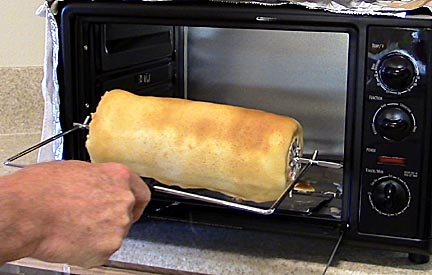
Once your
Baumkuchen is as large as you want, use the rotisserie fork that
comes with the oven to remove it and...
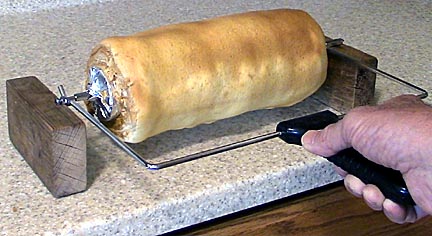
...place it
between two blocks to cool for at least half an hour before slicing.
I've
experimented with cooling it covered and uncovered and found that if covered,
trapped steam
tends to allow the cake to collapse and get slightly gummy.
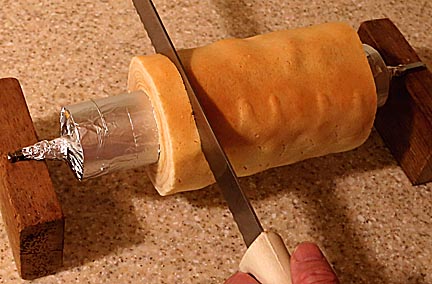
Slice...
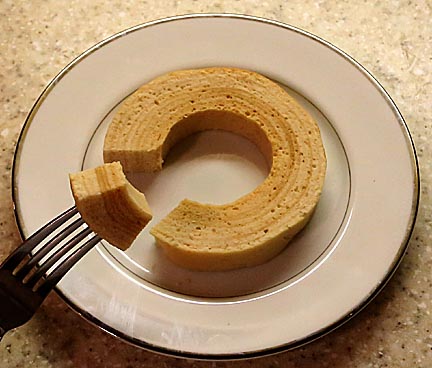
...and eat. Ahh... life is good.
This Baumkuchen only has 10 layers but nonetheless demonstrates that this technique works.
Here's a video showing the entire process:
While this
classic recipe for traditional Baumkuchen is good, I personally
thought it tasted overly eggy and was a little tough. I was reluctant
at first to change it because the goal of this page was to present a
technique for making traditional German Baumkuchen. Further research
disclosed the fact that in reality there is no single recipe for real
Baumkuchen. Every baker develops a slightly different formula that
complements his or her tastes and the peculiarities of their
equipment. With that in mind, I decided I was free to explore
non-traditional options.
Since so much effort is required to make the specialized equipment for Baumkuchen, I elected to simplify the batter as much as possible. I went for a boxed cake mix.
It's safe to assume that thousands of die-hard bakers are cringing at the thought of using a ready-made mix, but the fact is that when properly adapted these mixes can produce outstanding results. (I refer you to: "CAKE! How to make the best tasting cakes from mixes" for proof of this.) I decided to use my favorite cake: Betty Crocker's Golden Vanilla made with whole milk instead of water and squeeze Parkay margarine instead of vegetable oil. This produces a cake with a deep, rich flavor that is also wonderfully moist.
If made with that same amount of liquid as specified in the instructions on the box, the batter is too thick to properly flow onto the cylinder. Increasing the milk from 1 and 1/4 cups to 1 and 3/4 cups thins it out enough to work. Separating the eggs, whipping the whites to firm peaks and folding them into the batter makes the cake more delicate. The resulting Baumkuchen has a much better flavor than the traditional recipe and is lighter. Using mixes also make it easy to try alternate flavors, though darker colored batters won't show the ring structure as well as lighter ones.
UPDATE!!!
WARNING
NO ONE SHOULD EVER ATTEMPT WHAT I AM ABOUT TO DESCRIBE.
DOING SO CREATES A SERIOUS RISK OF FIRE, INJURY, ELECTROCUTION AND DEATH.
IT IS BEING PRESENTED ONLY FOR ENTERTAINMENT PURPOSES.
In
the interests of increasing the heat produced by the oven while in
rotisserie mode, I removed the oven's shell and modified it three ways.
First, I filled the 1-inch gap between the inside top of the oven and the outside top with alternating layers of cake racks and aluminum foil. This created a double thermal radiation barrier, which greatly reduced the loss of heat through the top of the oven.
Second, I rewired the rotisserie motor so that it would operate when the oven was set to "bake." This enabled the rotisserie to operate while all four heating elements were energized, doubling the heat output over the original configuration where only the top two elements were active.
Third, I rewired the thermostat so that it would not turn off in "bake" when the temperature got above 460 degrees F. This is the same as when the oven is in "broil," except all four heating elements are active.
The
cumulative effect of these modifications was to reduce the baking
time for a layer to be browned to three minutes. This faster baking
resulted in a lighter, moister cake and a browned layer that was more
attractively defined. It also reduced the overall baking time from
3.5 hours to less than two hours.
With
these changes I was able to make the following Baumkuchen in two hours:

This is the best Baumkuchen I have ever made. It's six inches in diameter and packed with deep, rich, moist flavor. Although it appears to have only nine layers, in fact only one out of every four was allowed to brown so it really has 36. The layers are beautifully uniform in thickness. It took three boxes of Betty Crocker Golden Vanilla cake mix to make. Increasing the whole milk to two cups improved how it flowed onto the cake. I didn't beat the eggs whites and fold them into the mix because I found the leavening in the mix provided more than enough raising. After trimming off the ends, the finished cake measured six inches in diameter and ten inches high. Although that may not sound large it looked massive.
Served at a recent family gathering I had to beat people back with a stick because they kept coming back for seconds, and thirds, and even fourths. Everyone liked it plain, but some preferred it topped with a little whipped cream I made using the best recipe I know of, which you get on my page: WHIPPED CREAM DELIGHTS.
Conclusion
Baumkuchen is dense like pound cake. This is to be expected because as each layer bakes a lot more moisture can escape than in a conventional cake. But this isn't all bad because it means flavor is concentrated in every bite.
This page has shown how anyone can make traditional German Baumkuchen at home. Yes, it's complicated. Yes, it takes several hours applying layer after layer of batter to build up to a respectable diameter. But consider, this is a cake that heretofore has been proclaimed by countless experts as being impossible for the home baker to make. I experienced a sly delight in proving them wrong. I hope you will too.
Return to my main page to browse 60 other subjects